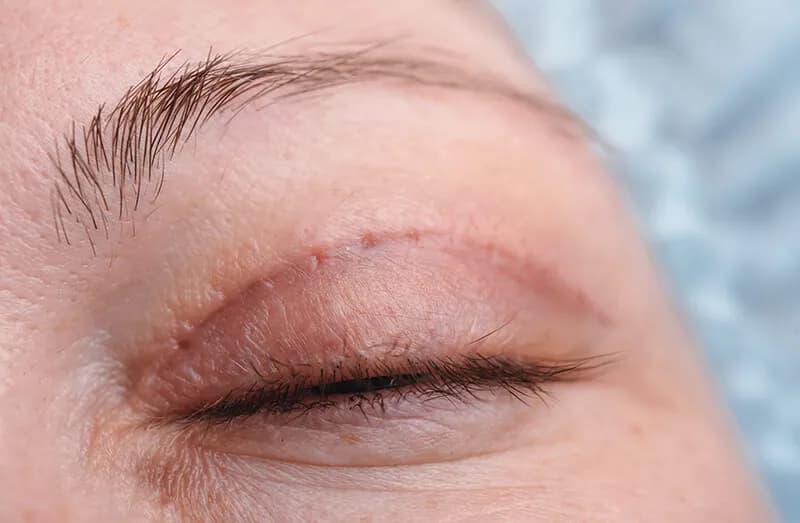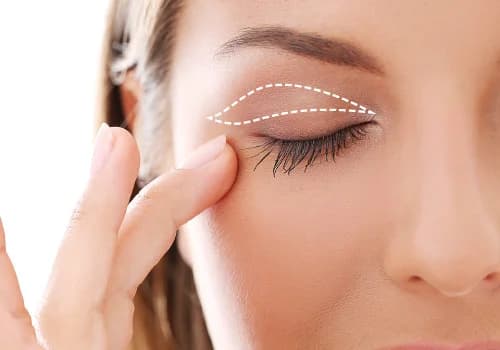During an upper blepharoplasty, the appearance of the upper eyelids is improved by tightening skin, correcting the level of droopy eyelids, or removing excess skin. Eyelid surgery is the most common facial cosmetic surgery following a facelift. Since your eyelids have an important impact on your overall appearance, their rejuvenation may improve your appearance and help you feel younger. In many instances, the procedure may increase the amount of light entering the eye and improve the quality of vision.
As we age, our eyelids will begin to droop or sag, resulting in tired eyes, which a facial rejuvenation surgery can reverse. It will not, however, remove crow’s feet or other wrinkles, or lift sagging eyebrows. Blepharoplasty can be done alone or in conjunction with other facial surgery procedures such as a facelift or brow lift.
Patients seeking an eyelidrejuvenationsurgery, are often expecting to correct:
Looking tired or fatigued
Heavy, droopy lids
Undereye bags or puffiness
Excess, wrinkled, crepey skin
These surgeries focus on improving the three main tissue components of the lids: skin, muscle, and fat, which will successfully correct these issues.

How does aging affect eyelids?
With aging, your skin will gradually lose its elasticity. When a lack of elasticity and gravity’s pull combine, they’ll result in excessive skin collecting in the upper and lower eyelids. On the upper eyelids, an extra fold of skin forms that can hang over the eyelashes and obstruct vision. Bulges on the upper and lower eyelids can also be caused by the fat that cushions the eyeball from the eye socket. The thin membrane that holds the fat in place weakens with age, allowing the fat to protrude into the lids.
What Is Upper Eyelid Rejuvenation Surgery?
Blepharoplastyis an increasingly popular cosmetic surgery that addresses puffiness and sagging in the eyelids. Those interested in improving the overall appearance of their upper eyelids will choose the upper eyelids surgery since it’s becoming heavy and/or because the skin is starting to hang. In some cases, the patient’s vision is impacted with part of the visual field being obscured by the hanging eyelids. The medical term that describes a droopy upper eyelid due to poor eyelid muscle function is ptosis, and it may be either congenital or a result of several different conditions, including changes in the muscle due to age or temporary weakening from Botox injections. The upper blepharoplasty procedure removes any excess skin, as well as any fat that is underneath the muscles, often causing problems. As expected, the facial rejuvenation procedure results in a more open and refreshed look.
Patients need a meticulous evaluation of their anatomy and ophthalmologic examination pre-operation and eliciting any history of eye problems such as dry eye. The function of the specialized muscles that lift the upper eyelid should be assessed before eyelid surgery to determine if it is functioning properly. Ptosis repair may be performed concurrently with cosmetic eyelid surgery to ensure an optimal result.

Who is a candidate for blepharoplasty?
The best candidates for blepharoplasty are patients with physical health, psychological stability, and realistic expectations. Although patients with a strong family history of baggy eyelids may undergo sooner, most patients are 35 or older.
A few medical conditions make blepharoplasty riskier. These include thyroid problems such as hypothyroidism and Grave’s disease, dry eyes or lack of sufficient tears, high blood pressure (uncontrolled) or other circulatory disorders, cardiovascular disease, and diabetes. A detached retina or glaucoma are also reasons for caution.
Eyelid Surgery Side Effects
Although side effects from eye lifts are, they sometimes occur, which include:
Bleeding
Infection
Abnormal color of the eyelids
Dry eye
Abnormal skin folds on the eyelids
Difficulty closing your eyes or other eyelid problems
Loss of vision
Significant scarring
Need for the second surgery

Blepharoplasty Recovery
Upper-lid blepharoplasty is performed under local anesthesia, and patients can go home the same day. Surgery involves resection of skin excess from across the upper eyelid and closure of the wound using very fine sutures. The scar is hardly noticeable 2-3 weeks after. Even after upper eyelid surgery, the swelling and bruising tend to accumulate in the area of the lower lids.
Are the Results of Blepharoplasty Permanent?
It would be best if you kept in mind that blepharoplasty will not stop your eyes from aging, but only reverse some of it. The results of an upper-eyelid surgery can last around 5-7 years to an entire lifetime, while lower-eyelid surgery rarely needs to be done more than once.
Conclusion
Upper blepharoplasty, also known as eyelid surgery, plays a pivotal role in facial rejuvenation. It is a surgical procedure designed to remove excess skin and fat deposits from the upper eyelid. This procedure is particularly effective in addressing age-related changes in the upper eyelids, such as drooping or puffiness, which can give the face a tired or aged appearance. Despite the advancement of non-surgical treatments, upper blepharoplasty remains irreplaceable for treating skin redundancy and herniation of fat pockets. With a long history in dermatology, it continues to be the treatment of choice for achieving excellent aesthetic and functional results in facial rejuvenation.
Read more: